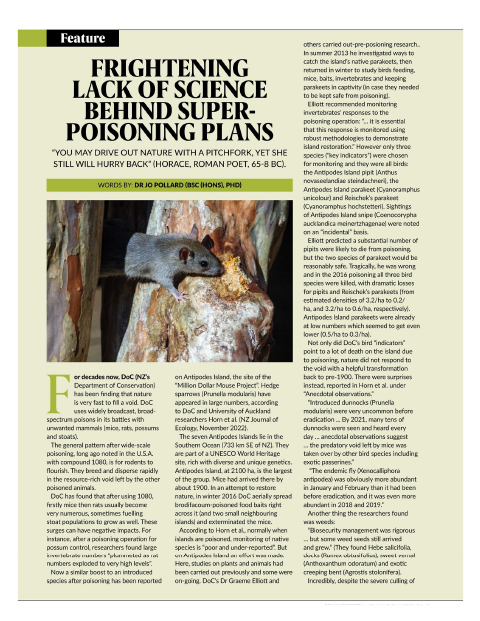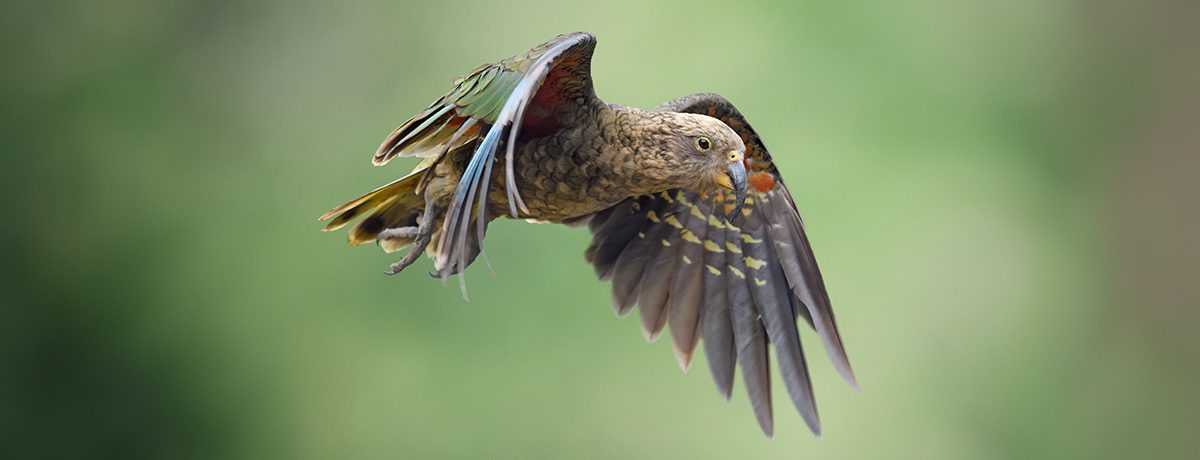Frightening Lack of Science Behind Super-Poisoning Plans
Published in Hunting and Wildlife, Summer 2023
Dr Jo Pollard (BSc (Hons), PhD)
“You may drive out Nature with a pitchfork, yet she still will hurry back”
(Horace, Roman poet, 65-8 BC).

For decades now, DoC (NZ’s Department of Conservation) has been finding that nature is very fast to fill a void. DoC uses widely broadcast, broad-spectrum poisons in its battles with unwanted mammals (mice, rats, possums and stoats).
The general pattern after wide-scale poisoning, long ago noted in the U.S.A. with compound 1080, is for rodents to flourish. They breed and disperse rapidly in the resource-rich void left by the other poisoned animals.
DoC has found that after using 1080, firstly mice then rats usually become very numerous, sometimes fuelling stoat populations to grow as well. These surges can have negative impacts. For instance, after a poisoning operation for possum control, researchers found large invertebrate numbers “plummeted as rat numbers exploded to very high levels”.
Now a similar boost to an introduced species after poisoning has been reported on Antipodes Island, the site of the “Million Dollar Mouse Project”. Hedge sparrows (Prunella modularis) have appeared in large numbers, according to DoC and University of Auckland researchers Horn et al. (NZ Journal of Ecology, November 2022).
The seven Antipodes Islands lie in the Southern Ocean (733 km SE of NZ). They are part of a UNESCO World Heritage site, rich with diverse and unique genetics. Antipodes Island, at 2100 ha, is the largest of the group. Mice had arrived there by about 1900. In an attempt to restore nature, in winter 2016 DoC aerially spread brodifacoum-poisoned food baits right across it (and two small neighbouring islands) and exterminated the mice.
According to Horn et al., normally when islands are poisoned, monitoring of native species is “poor and under-reported”. But on Antipodes Island an effort was made. Here, studies on plants and animals had been carried out previously and some were on-going. DoC’s Dr Graeme Elliott and others carried out pre-poisoning research. In summer 2013 they investigated ways to catch the island’s native parakeets, then returned in winter to study birds feeding, mice, baits, invertebrates and keeping parakeets in captivity (in case they needed to be kept safe from poisoning).
Elliott recommended monitoring invertebrates’ responses to the poisoning operation: “… it is essential that this response is monitored using robust methodologies to demonstrate island restoration.” However only three species (“key indicators”) were chosen for monitoring and they were all birds: the Antipodes Island pipit (Anthus novaseelandiae steindachneri), the Antipodes Island parakeet (Cyanoramphus unicolour) and Reischek’s parakeet (Cyanoramphus hochstetteri). Sightings of Antipodes Island snipe (Coenocorypha aucklandica meinertzhagenae) were noted on an “incidental” basis.
Elliott predicted a substantial number of pipits were likely to die from poisoning, but the two species of parakeet would be reasonably safe. Tragically, he was wrong and in the 2016 poisoning all three bird species were killed, with dramatic losses for pipits and Reischek’s parakeets (from estimated densities of 3.2/ha to 0.2/ha, and 3.2/ha to 0.6/ha, respectively). Antipodes Island parakeets were already at low numbers which seemed to get even lower (0.5/ha to 0.3/ha).
Not only did DoC’s bird “indicators” point to a lot of death on the island due to poisoning, nature did not respond to the void with a helpful transformation back to pre-1900. There were surprises instead, reported in Horn et al. under “Anecdotal observations.”
“Introduced dunnocks (Prunella modularis) were very uncommon before eradication … By 2021, many tens of dunnocks were seen and heard every day … anecdotal observations suggest … the predatory void left by mice was taken over by other bird species including exotic passerines.”
“The endemic fly (Xenocalliphora antipodea) was obviously more abundant in January and February than it had been before eradication, and it was even more abundant in 2018 and 2019.”
Another thing the researchers found was weeds:
“Biosecurity management was rigorous … but some weed seeds still arrived and grew.” (They found Hebe salicifolia, docks (Rumex obtusifolius), sweet vernal (Anthoxanthum odoratum) and exotic creeping bent (Agrostis stolonifera).
Incredibly, despite the severe culling of indicator species, the apparent takeover by hedge sparrows, and other signs of on-going ecological mayhem, Horn et al. have presented the poison operation as a success, because it killed all the mice. And because, the authors claim, the monitored bird species have become more numerous. But their data does not support this for Antipodes parakeets or snipe, and for the other two bird species, this claim rests on dubious assumptions and only one season pre-poisoning (2014). Tellingly, Horn et al.’s published graphs are full of errors, which make them look slightly more convincing that there was a rise in bird numbers.
The “success” of the Antipodes Island poisoning is being used to bolster the next major island poisoning. DoC is to finish off its clearing of mammals from NZ’s sub-Antarctic islands by poisoning the largest of all, Auckland Island (46,000 ha).
Restoring nature has not gone well on islands closer to shore – in Fiordland, where predators (Norway rats and stoats) were removed, South Island robins (Petroica australis) have flourished and ousted other species.
Meanwhile, on the mainland, heavy duty poisoning programmes are being used to quell pests on the conservation estate. Pest control entity ZIP (Zero Invasive Predators) researchers reported how by aerially poisoning twice a few months apart, spreading baits at extra high density, they managed to nearly get rid of all rats, stoats and possums (Nichols et al. 2021, NZ Journal of Ecology). Unbelievably, monitoring of any other creatures’ survival or recovery was only “incidental and anecdotal.”
ZIP’s super-poisoning technique is now being scaled up to cover 100,000 ha of Westland. ZIP’s aim to eliminate all rats should be a grave concern to nature lovers, considering rats are one of the most resilient animals on the planet. That nobody should trust either ZIP or DoC to care about by-kill was made clear in November 2021 when ZIP poisoned over 550 black-backed gulls (Larus dominicanus), whose bodies appeared on the beaches of a Westland river. DoC defended ZIP, saying they hadn’t known there had been so many gulls in the area (OIA request, 18/3/22). Then more of the gulls were killed by ZIP’s poisoning in May 2022. The fact that many more species were likely being culled severely, but less obviously, was not acknowledged by either party.
Also on the mainland, OSPRI is, as usual, busy aerially spreading poison over wildlands, farms and planted forests, with transparently no reason whatsoever. The Biosecurity Act (1993) allows wide-scale poisoning to be forced upon land owners wherever an authorised officer “considers” it to be “necessary or expedient” for managing bovine tuberculosis. There is no need for science or even common sense: just dipping into their plans for 2023 you find examples such as 2900 hectares in Conway-Waiau, in North Canterbury, is to be aerially poisoned because historically there was a Tb problem. Since 2013 there have been no reports of Tb in livestock, possums or OSPRI’s sampled ferrets or wild pigs (considered an especially sensitive, “sentinel” indicator of Tb).
NZ’s aerial spreading of broad spectrum poison takes a heavy toll. Ecological systems are upset, native animals are killed and resources for humans (e.g. hunted animals, safe enjoyment of the outdoors) are diminished. There is also unimaginable suffering for the victims of the poisoning – hours of spasms with 1080, weeks of sickness with brodifacoum, as well as debility and bereavement for survivors. The observed negative effects appear to grossly outweigh the observed positive effects. Formal scientific scrutiny is needed, urgently.






